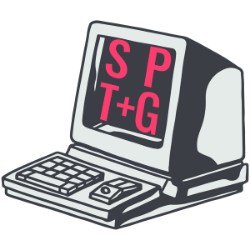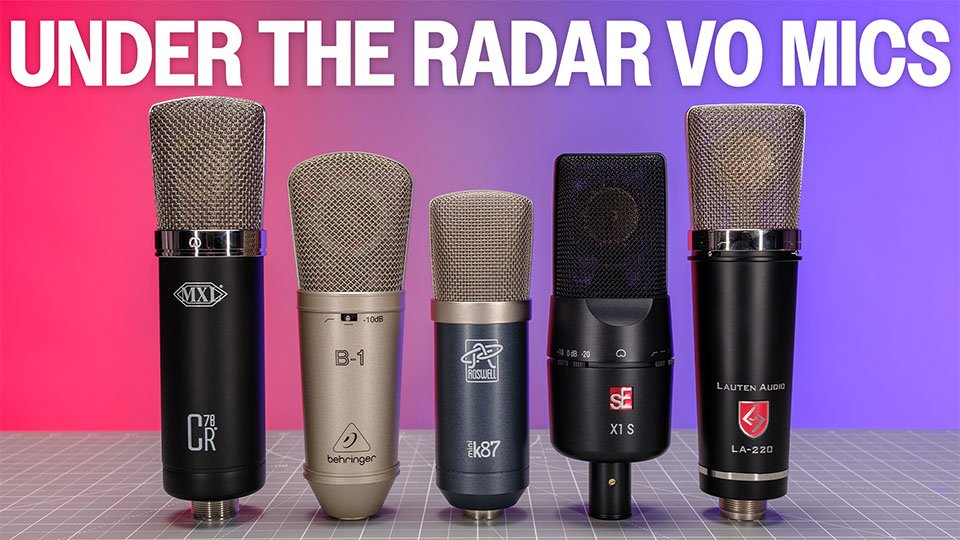Links in this post may be affiliate links. Any products purchased through affiliate links may provide a small commission which helps to support the SemiPro Tech+Gear site and YouTube channel.
Being the audio nerd that I am, one of my favorite things to do is trying out different microphones for the voiceover work that I do on the side. Below I’ve compiled a list of five microphones that you could consider “under the radar” for dialog recording. Now I don’t mean that nobody’s ever heard of these mics, but they don’t get the same type of coverage on YouTube or review sites as microphones like the Rode NT1 or Neumann TLM103.
All the microphones on this list are XLR large diaphragm condenser mics that require 48v of phantom power and a quiet space (preferably with some sound treatment) to get the best results for voiceover use. Any of these mics can be used to record a variety of things but my main use case is recording dialog. Each mic has an audio sample embedded below that I recorded including a more relaxed passage and a commercial-style ad spot. For notes on the recording settings, see the page bottom.
Let’s dive in.
1. MXL CR78

Price: $37.99 (amazon)
Polar Pattern: Cardioid
Frequency Response: 30 Hz – 20 kHz
Self Noise: 20 dBA
Sensitivity: 15 mV/Pa
Switches/Features: None
Output Circuitry: Transformerless
Sound Notes: The thinnest sounding on this list (least bass), needs the most EQ to sound polished but quite usable, a little harsh on the top end and sibilant sounds but surprisingly not bad for under $40.
The MXL CR78 offers something unique – a sound quality that can be used for multiple purposes for less than $40. It’s not without compromise of course, but if you’re looking to do some vocal recordings for content creation or dabble in some VO without making a big investment, this mic allows you to do that. My main issues with the CR78 are the thin low end and brittle quality of the higher frequencies (though it’s actually not the harshest-sounding mic on this list). The low end can be bolstered with a little EQ bump around 110Hz and a de-esser helps with sibilance. The self-noise of 20dBa is approaching the “kind of high” level for VO purposes, but I didn’t find it to be an issue. It also does not come with a shock mount or storage case. Those drawbacks considered, the CR78 is nonetheless a surprising value for $38.
2. Behringer B-1

Price: $80-109 (amazon)
Polar Pattern: Cardioid
Frequency Response: 20 Hz – 20 kHz
Self Noise: 13 dBA
Sensitivity: 20 mV/Pa
Switches/Features: -10dB pad or 75Hz HPF (not independent)
Output Circuitry: Transformerless
Sound Notes: Full low end (deeper voices will need to roll this off a bit), top end is a bit harsh, probably the most harsh on this list. The sound is the most V-shaped on this list, meaning the mids sound a bit scooped.
Another mic that offers some surprises for the price is the Behringer B-1. The shock mount included is admittedly not the best, but the hard storage case is actually pretty nice. The sound of the B-1 is the most V-shaped on this list, meaning the mids sound a little bit recessed while the top and bottom sound more forward. The low end could use some rolloff, especially on a deeper voice. And the top end is a little harsh, definitely not the best for a voice prone to sibilance. But with a little EQ balancing (or just on the right voice), the sound is very usable, especially for non-client work (such as narrating your own content). There is a built-in switch that offers either a 76Hz high pass filter or -10dB pad (it’s the same switch so only one can be used at a time). The self-noise is a respectable 13dBa which is quite good for this price point.
3. sE Electronics X1 S

Price: $150 (mic only) / $220 (kit)
Polar Pattern: Cardioid
Frequency Response: 20 Hz – 20 kHz
Self Noise: 9 dBA
Sensitivity: 30 mV/Pa
Switches/Features: HPF 80/160Hz, Pad -10/-20dB
Output Circuitry: Transformerless
Sound Notes: Controlled low end, less harsh on the top end but not ultra-smooth, a bit less scooped-sounding.
This mic is a good example of one that I have seen a view videos about, but not many from a VO perspective. The X1 S offers a very low self-noise of only 9dBa and a less V-shaped sound. It still leans a little bit on the high end, but it is’t as harsh as the Behringer B-1. The low end is also fairly controlled and less boomy as close working distances. This is the first mic on the list that I would recommend for use with client work because it doesn’t have any notable shortcomings in the sound. It also features multiple on-board controls for high pass filters and pads, making it a very multi-purpose mic that won’t break the bank.
4. Lauten Audio LA-220 V2

Price: $359
Polar Pattern: Cardioid
Frequency Response: 20 Hz – 20 kHz
Self Noise: <15 dBA
Sensitivity: 16 mV/Pa
Switches/Features: HPF 120Hz, LPF 12kHz
Output Circuitry: Transformer-balanced
Sound Notes: Present but controlled low end, clear mids, top end is slightly bright but not harsh. Required the least EQ to sound “ready to publish” for my voice.
We’ve jumped from the $150-200 price range up to the $300+ range with the LA220 V2 from Lauten Audio. I picked this mic up just out of curiosity and came to enjoy it a lot more than I expected for narration of videos and commercial-style VO. There are two things that make this mic stand out, especially for an under-$400 condenser. The first is a low-pass filter which rolls off the high frequencies starting at 12kHz, and the second is a transformer-balanced output. The high-pass filter is not necessarily something you’ll want to use for voiceover purposes, but it can actually help to cut out reverb in a less-than-ideal environment (but it will also cut out some of the “air” in the sound, so experiment at your own risk). The transformer-balanced output, however, gives the LA220 V2 a unique flavor to the sound that you don’t often find at this price point. Using a transformer in the output stage rather than electronic balancing imparts a slight saturation to the sound. It’s very subtle and you won’t get true distortion from it, but it does add a certain “cohesion” to the sound. The LA220 V2 has a present but controlled low end, clear mids, and a little top end bump it doesn’t come across as harsh. It could be a little bright on higher-pitched voices, but for me, this mic required the least EQ to sound “ready for broadcast” on this list.
5. Roswell Pro Audio Mini K87

Price: $399 – $459
Polar Pattern: Cardioid
Frequency Response: 20 Hz – 20 kHz
Self Noise: <11 dBA
Sensitivity: 14 mV/Pa
Switches/Features: None
Output Circuitry: Transformerless
Sound Notes: The most neutral sound on this list. Low end is a little boomy at VO range and benefits from a mild rolloff on deeper voices, top end is very smooth and does not emphasize sibilance. Takes EQ very well.
Yes, the MSRP of the Mini K87 is $459 with the shock mount and flight case, but I can squeak it onto this list because Roswell offers what they call “LC” versions of their microphones without the shock mount and case for $399. Roswell overall is a very interesting microphone company founded by microphone super-nerd Matt McGlynn who also created microphone-parts.com. McGlynn builds Roswell microphones by hand in California with premium internal components and no-frills exterior parts in order to give you premium performance at an affordable price. The “mini” line of mics are downright cute – smaller in size than many large diaphragm condensers – which actually can help keep them from blocking your script/screen. The Mini K87 delivers a wonderfully neutral sound with a smooth top end. There’s no V-shape here, and the sound of the K87 takes EQ very well. The low end can get a little boomy at VO working distances, but a high pass filter helps to clear it up. If other mics highlight sibilance too much for you, this one would be worth a look.
Conclusion
I love testing out different mics for dialog recording, especially when they’re not headline-grabbing popular mics that everyone has tried. These mics all offer the opportunity to record dialog effectively, ranging from a mere $38 up to $400+. If you’re interested in recording dialog for client VO work, I personally would recommend the sE X1 S, Lauten LA220 V2, or Mini K87 from this list. Of course there are dozens of other options out there and this was not intended as a “best mic” list, so just keep that in mind. I’m only hoping to provide some reference points for mics that get less coverage from the VO perspective. I hope it was helpful!
Audio Sample Notes: All samples recorded through a MOTU Ultralite Mk5, 24-bit/48kHz. No post-processing applied other than normalizing to -23 LUFS. Original wav files exported to VBR mp3 files due to size constraints.


